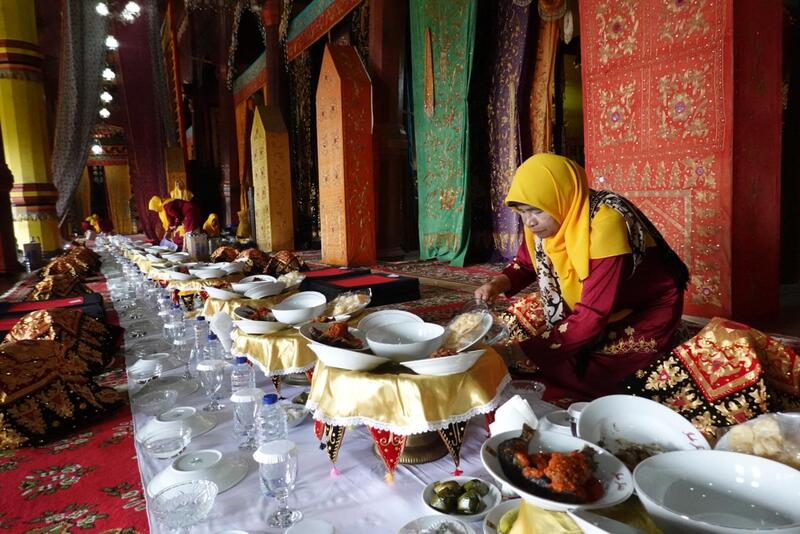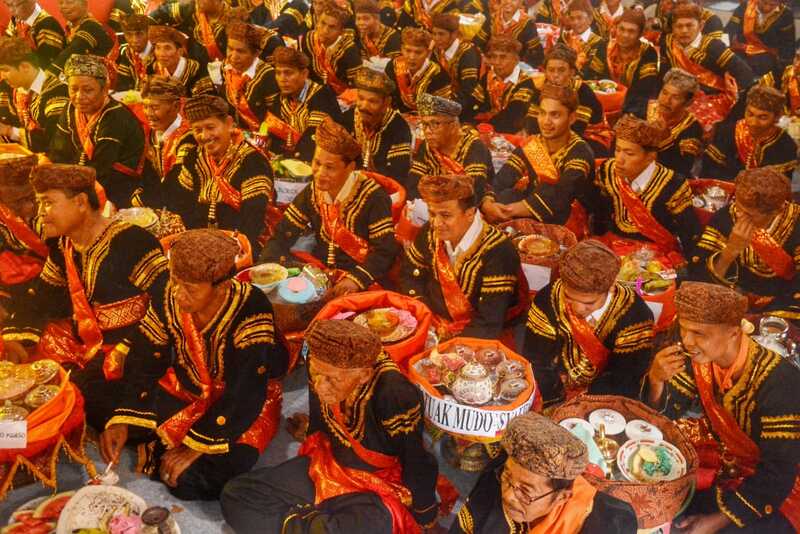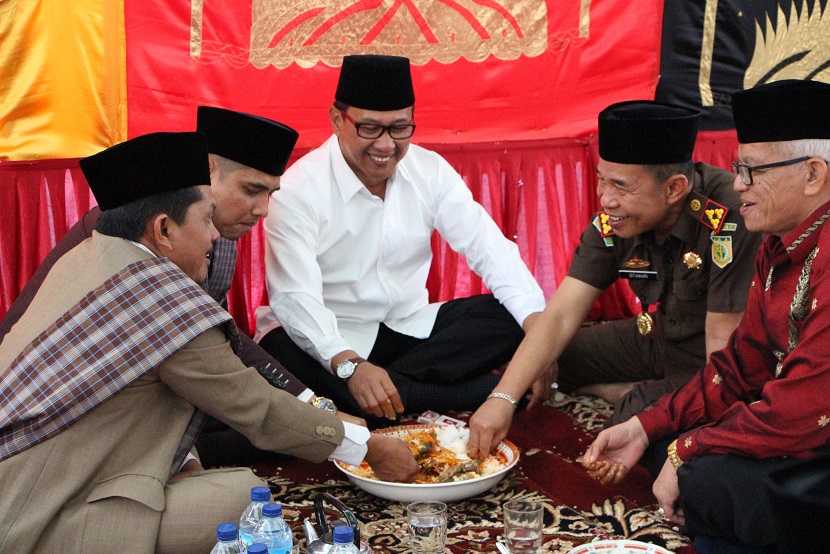Almost all regions have a communal dining tradition in Indonesia, including West Sumatra. For Minangnese people living in West Sumatra, makan bajamba is a traditional way of eating passed down from generation to generation.
It is a tradition of the Minangnese people that has existed since the founding of Islam and is conducted at ceremonial events, holidays, festivals, and important gatherings.
Makan bajamba means sharing a meal on a platter while sitting on the floor. It aims to bring a sense of togetherness, regardless of social status. Everybody should lower their ego while joining this event. There is no signature main course in makan bajamba. All menus can be served with steamed rice, but some areas prepare and offer their local cuisine. The mandatory menu item is rendang, although not necessarily beef rendang. Some provide egg, chicken, and veggie rendang, depending on their respective regions in the province.
The people holding makan bajamba in the Koto Gadang area are accustomed to serving itiak lado mudo. It is a flash-grilled duck that is then slathered in a luxurious bath of spices and green chillies before it is finished in a thick stew. In the Tanah Datar region, makan bajamba is served with bamboo shoot curries. In one big tray or platter, five kinds of dishes are generally served and can be eaten with steamed rice and complementary chilli sauce. Four to seven people will dine on one big tray or platter.
Before the dining process kicks off, the host runs a series of events. Attending guests will be invited to sit on the floor. Food isn’t directly served in front of guests. The host and guest representatives will exchange pepatah petitih – the recitation of traditional Minangkabau proverbs – or pasambahan – traditional speech – in the Minangnese language. It has simple but deep messages. It further comprises a welcome greeting and invites the guests to enjoy the meals provided. The guest representatives will reply with another traditional speech talking about gratitude for the host’s warm welcome.
Before the dish is placed, the guests are allowed to sit in a line along the side of the house. They sit facing the house’s interior side, while the host members sit in a row facing the house windows. Male and female guests occupy separate parts of the house. Guests with kids will sit at the end of the house together with other children.
Though the dining procedure is not bound to one’s social status, this tradition still upholds courtesy. The oldest person must take precedence when washing hands or eating food. Each must eat calmly and slowly no matter how hungry they are. Sharing a meal in one tray or platter means the sitting position is close and tight. For this reason, belching or coughing is prohibited while consuming food. If you cannot hold them, try to look back and cover your mouth while coughing or burping with your hand.
Along with some side dishes, a mouthful of rice is taken with the right hand while eating. When the right hand is taking the rice, the left hand must be underneath to avoid possible scattered or fallen rice. Not a single morsel of food must not be left on the tray. You must eat it all. This is the way to revere those who have cooked and prepared the meals in the kitchen.
There is a main dish called kapalo samba, in spite of various dishes being served. It is not to be served to invited guests; it’s for display only. Even though it is very tempting, they cannot taste it because this is only for the host. Kapalo samba is a very large beef rendang, generally weighing one kilogram or more. It is left intact in large chunks instead of being cut into pieces.
Makan bajamba reinforces a grateful attitude and encourages you to not eat too much out of sheer greed. While sharing a meal, you are simply allowed to take the food in front of you and are prohibited from taking a share from others’ part. When the food in your section is up, it means that you are done. Your sitting posture must be culturally taken into account. The males have to sit cross-legged whilst the females have to basimpuah – to sit with both legs folded to the side.
As everybody finishes his or her meals, the elders take the first turn to wash their hands. When the young people have finished eating, they are not allowed to wash their hands before their elders. When all the guests have finished eating, then juaro, or a servant, will clean up the rest of the dishes. After the eating place is clean, the juaro will return to serve desserts — lemang (glutinous rice), cakes, pinyaram (traditional cake made of brown sugar), banana, wajik (sweet and sticky rice), and gelamai (traditional fudge) — known as parabuang. Once the makan bajamba procession is over, guests and host exchange their flowery speech expressing the gratitude received and asking for a safe return home.
Makan bajamba serves to strengthen the bonds of people who rarely meet. Kinship is to be established within a community. Many outlandish relatives coming from overseas or other places in the country find makan bajamba a deep and relieving meeting point. Old and young people share meals oblivious to their position in a social hierarchy. It is crucial to note that a 2006 procession that celebrated the 123rd anniversary of the town of Sawahlunto received an award from the MURI (Indonesian Record Museum) in the category of the longest and most participants in a makan bajamba procession (16,123 people).




